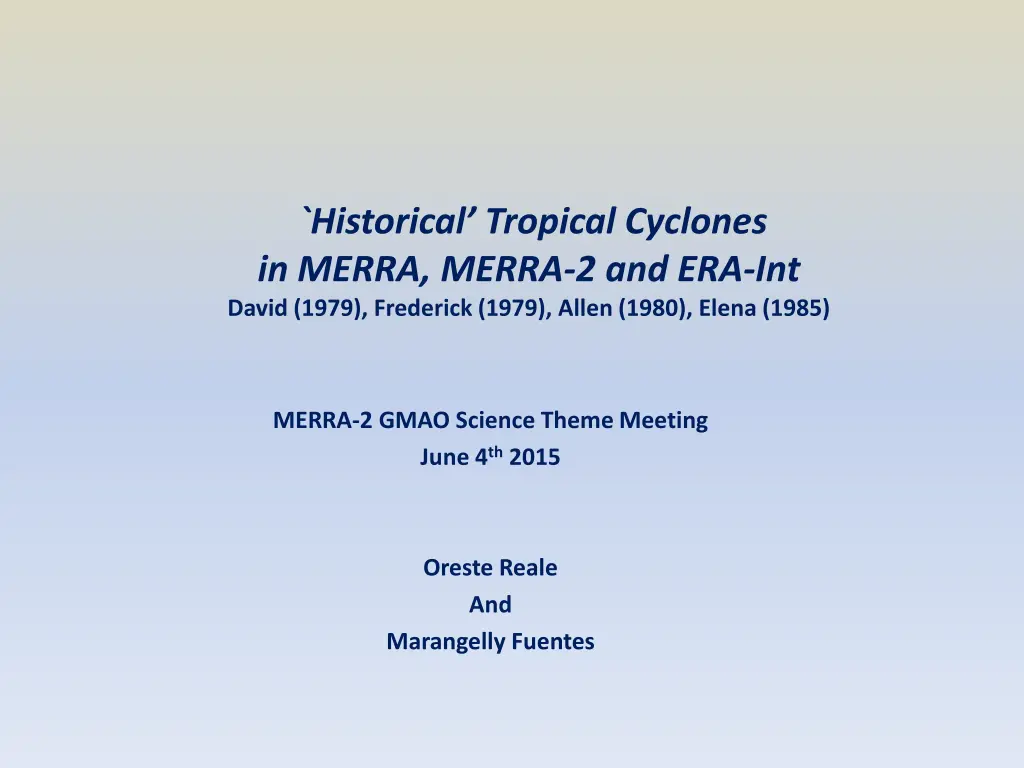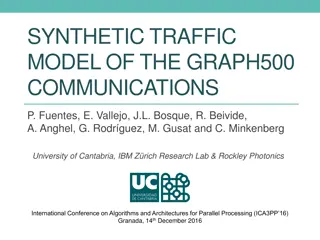
Examining Hurricane David (1979) Through Improved Weather Data Analysis
Explore the historical significance of Hurricane David in 1979 and the advancements in weather data analysis from MERRA to MERRA-2. Discover the impact of this intense storm on the Dominica island and the ongoing research to enhance tropical cyclone studies.
Download Presentation

Please find below an Image/Link to download the presentation.
The content on the website is provided AS IS for your information and personal use only. It may not be sold, licensed, or shared on other websites without obtaining consent from the author. If you encounter any issues during the download, it is possible that the publisher has removed the file from their server.
You are allowed to download the files provided on this website for personal or commercial use, subject to the condition that they are used lawfully. All files are the property of their respective owners.
The content on the website is provided AS IS for your information and personal use only. It may not be sold, licensed, or shared on other websites without obtaining consent from the author.
E N D
Presentation Transcript
`Historical Tropical Cyclones in MERRA, MERRA-2 and ERA-Int David (1979), Frederick (1979), Allen (1980), Elena (1985) MERRA-2 GMAO Science Theme Meeting June 4th2015 Oreste Reale And Marangelly Fuentes
Ongoing work and motivation for this talk The representation of tropical cyclones structure from MERRA to MERRA-2 has drastically improved Years examined so far: 1979, 1980, 1985, 2005 Consistent improvements noted with respect to MERRA and ERA-I The improvements are particularly important for the early years. In fact, reanalyses of early, `historical systems (which have never been studied through global analyses) have immense implications in hurricane studies It is possible to -revisit- those systems in light of MERRA-2
Hurricane David (1979) Cape Verde system originated off the W African coast on Aug 25th Reached 924 hPa, 150 kt (cat 5) Few storms before produced damages so widespread (Lesser Antilles, Puerto Rico, Hispaniola, US) Considered the most intense storm that ever affected the Dominica island 1000 casualties (floods)
Hurricane David (1979) Shaded: 850hPa Wind (m/s) Solid: slp (hPa)
Compactness at peak intensity evaluated from a very small sample (Atlantic only) in free-running models and reanalyses Obs hurricane (HH flights) = 0.03-0.15 ECMWF NR T511 0.15-0.25 GMAO NR c1440 0.05-0.2 ERA-I 0.2-0.3 MERRA 0.2-0.3 MERRA-2 0.1-0.2 0.1 is the lower limit for a half degree resolution
Hurricane David (1979): divergence structure Divergence 10^-5 s^-1
Hurricane David (1979) Divergence Vertical structure Only divergence Only convergence Divergence 10^-5 s^-1
Hurricane Frederic (1979) Cape Verde originated from a wave off the W African Coast on August 27th Followed David of a few days 19th costliest mainland TC from 1900 (18th if adjusted for inflation) $2,300,000,000 (mostly AL/MS) 943 hPa and 115 kt at 12z12Sep (Cat3-Cat4), very close to landfall
Hurricane Frederic (1979) 12z12Sep 27.4N 87.0W 943 hPa 115 kt Shaded: 850hPa Wind (m/s) Solid: slp (hPa)
Hurricane Allen (1980) Anomalous Cat5 Cape Verde Hurricane In 1980 it was considered the second most severe hurricane in modern records Reached cat5 3 times (911, 899 and 909 hPa) Survived very strong shear Exceptional propagation speed (15-20kts) through the Caribbean >220 casualties in the Caribbean and 835,000 homeless (St. Lucia, Haiti, Jamaica) 500,000 people evacuated from coastal TX and LA Damages less than feared over the US because of sudden decrease in intensity before landfall
Hurricane Allen (1980) 18z07Aug 21.8N 86.4W 899 hPa 165 kt Shaded: 850hPa Wind (m/s) Solid: slp (hPa)
Hurricane Elena (1985) Anomalous Cape Verde Hurricane born as a wave around August 23rd Fought against Saharan Air Layer, developed very little initially Very fast propagation speed across the Atlantic Sudden intensification over the Gulf after crossing Cuba on Aug 29th Extremely erratic track over the Gulf with sharp turn E, full loop near FL panhandle and then track W 1,000,000 people evacuated from coastal TX and LA (largest evacuation in history until that time) Because of erratic track, people over the Eastern Gulf were requested to evacuate twice within a 3-day period Landfall near Biloxi (MS) with center pressure of 959 hPa Damages of 1.25 billion $
Hurricane Elena (1985) 18z01Sep 28.9N 84.8W 954 hPa 110 kt Shaded: 850hPa Wind (m/s) Solid: slp (hPa)
Preliminary conclusions and future work It is accepted that 0.5 is not a sufficient resolution to resolve TC structure (e.g., Lim et al. 2015) and only broad, diluted, `signatures of TCs can be detected However, MERRA-2 offers a dramatic improvement in the representation of TC structure and intensity with respect to MERRA and ERA-I, reaching the limit for its resolution Important information about environmental factors controlling TC genesis, development, track and dissipation can be obtained Immense potential for hurricane studies using downscaling techniques Future work: comprehensive assessment of all TC activity on all basins on all years (including Polar Lows and Med TC-like storms) The information on early, `historical systems which have only been studied through sfc observations, satellite imagery and synoptic tools, appears particularly valuable





